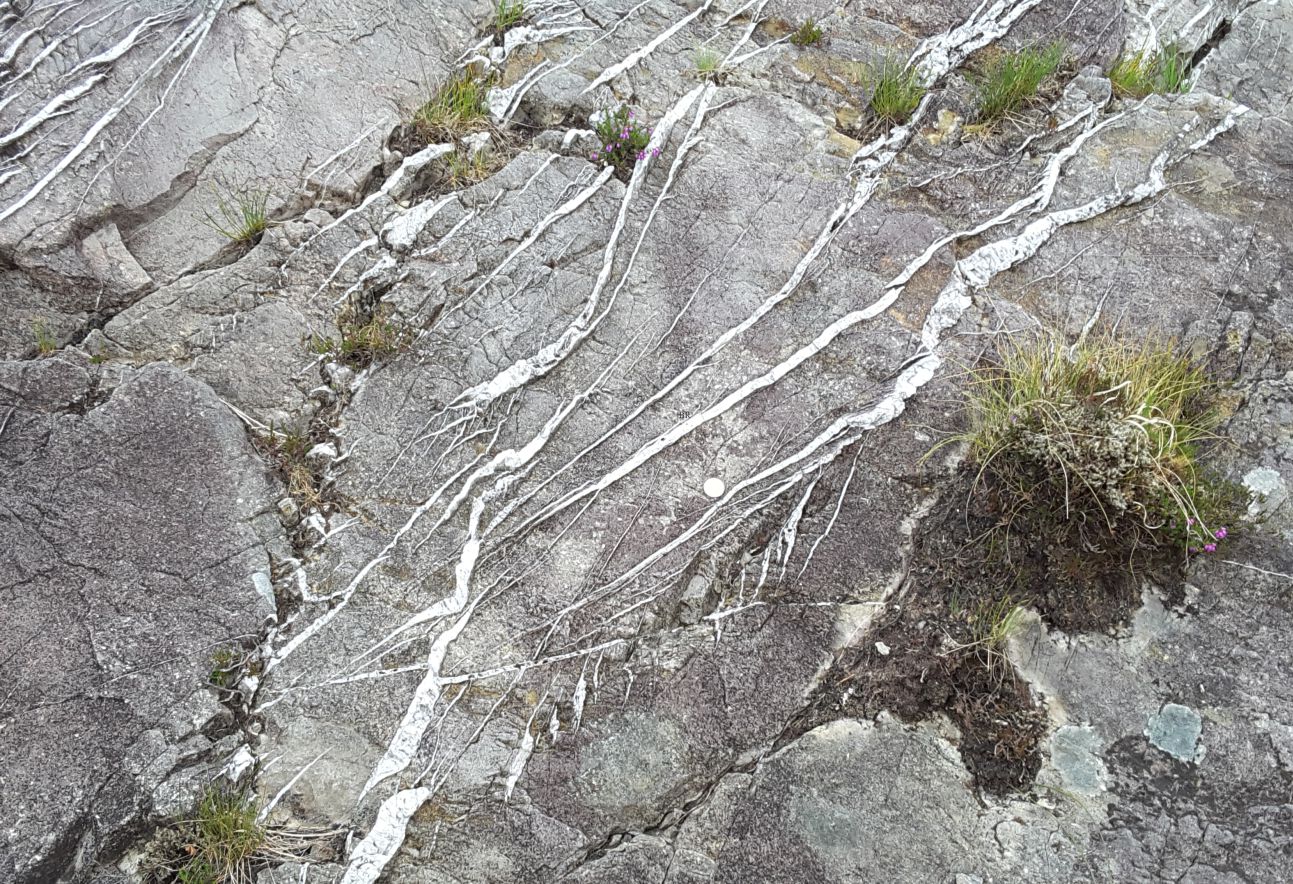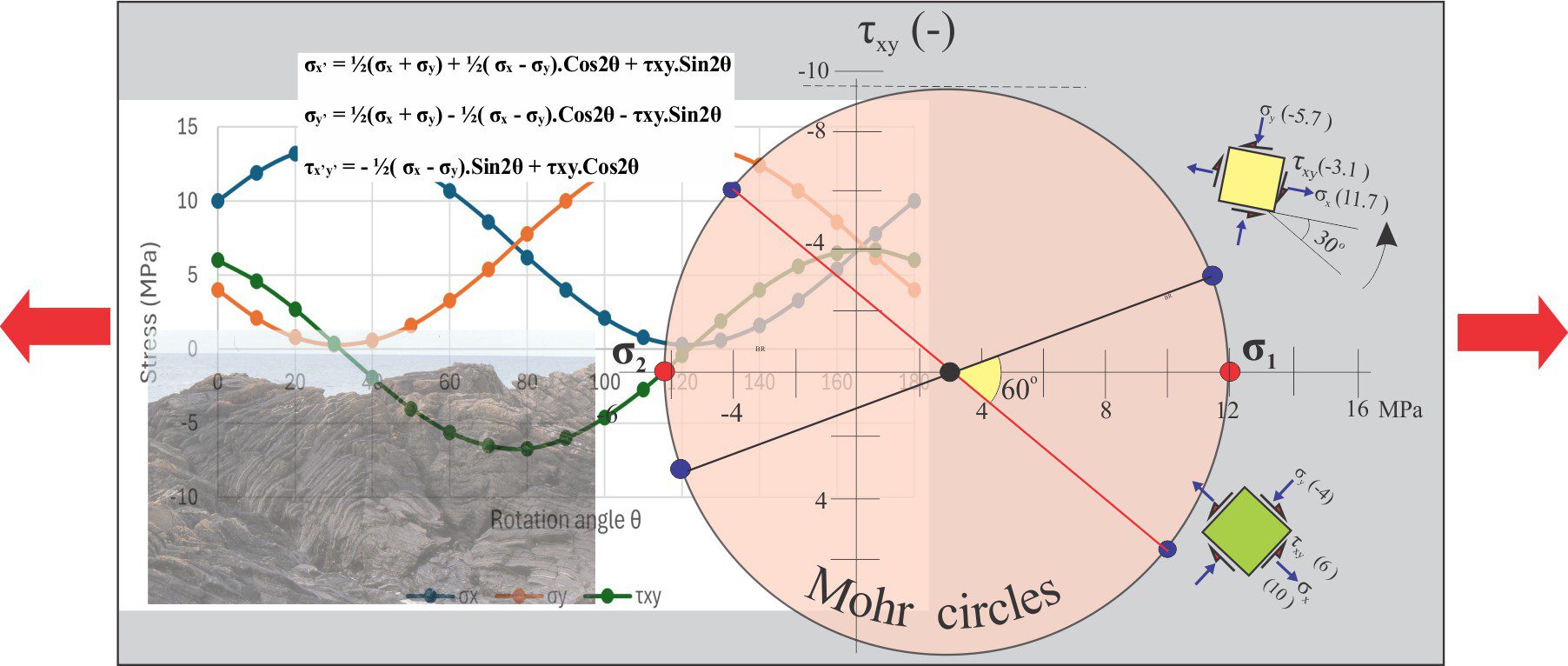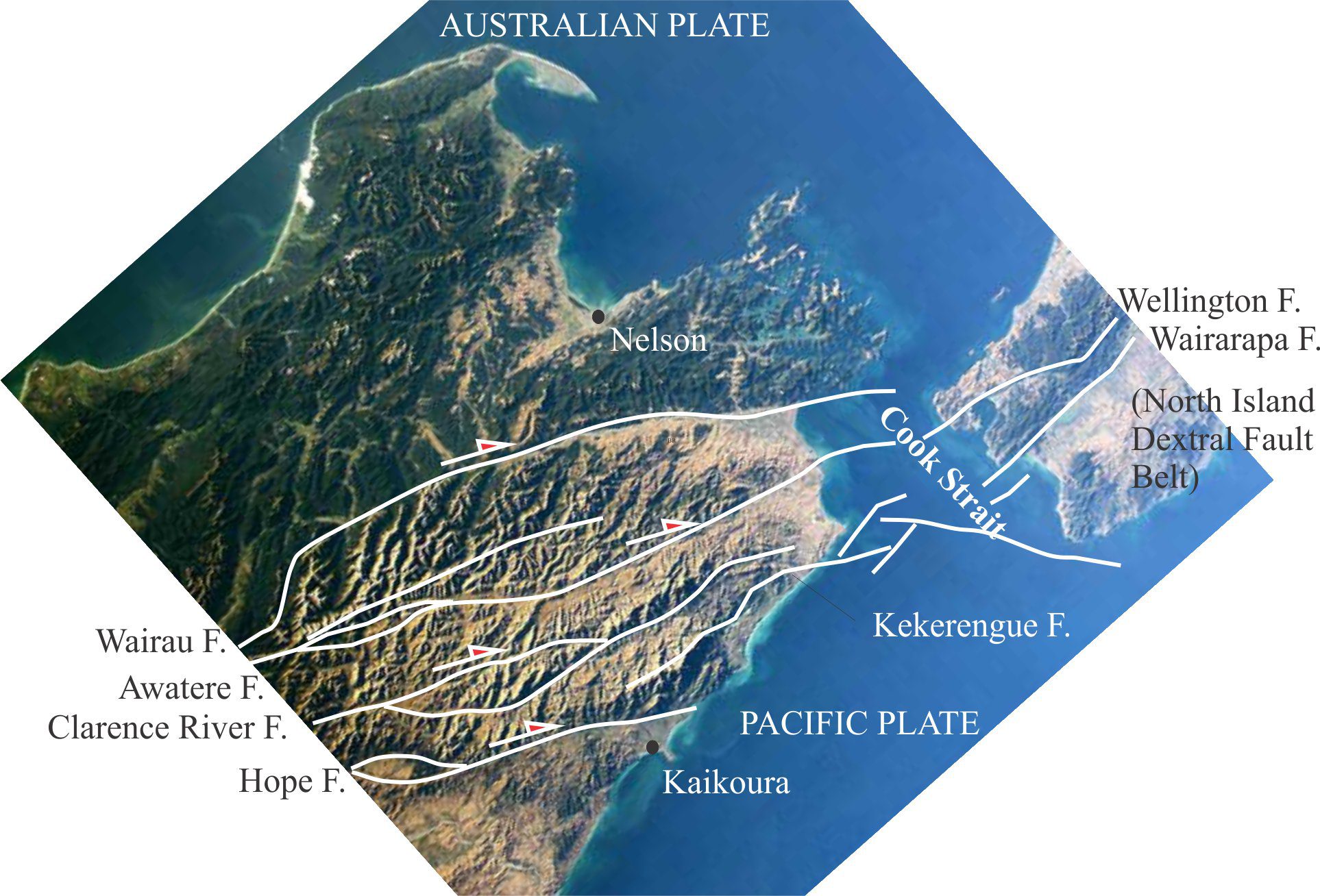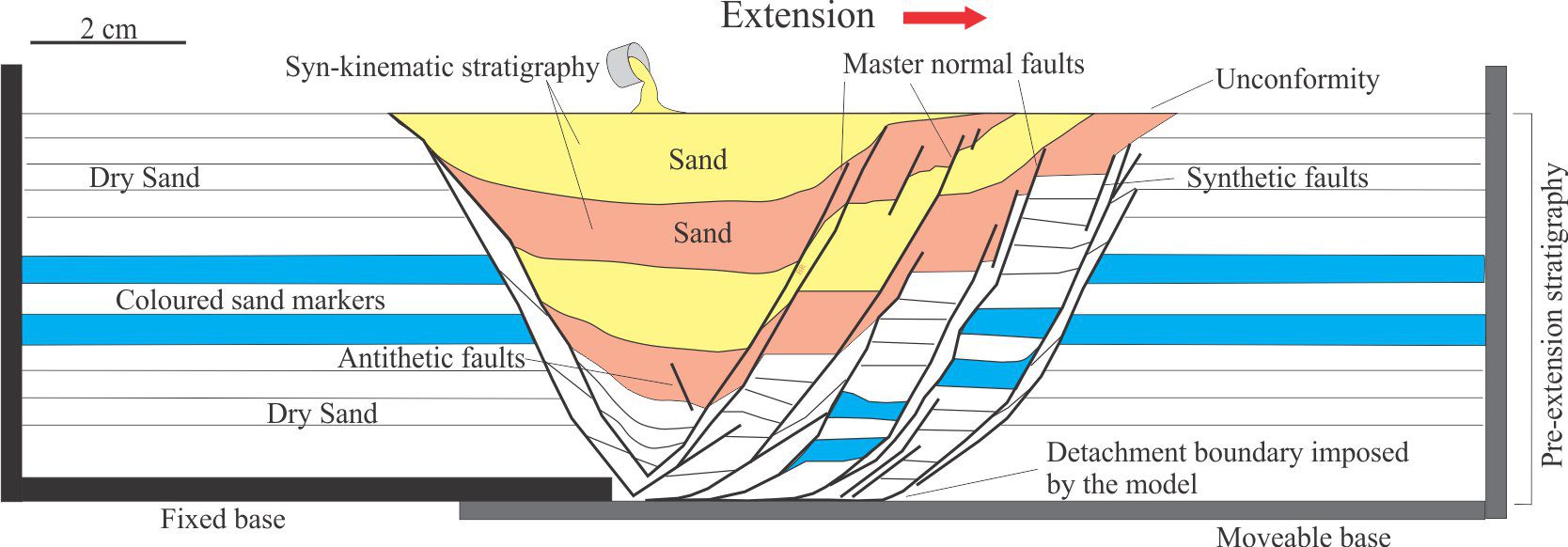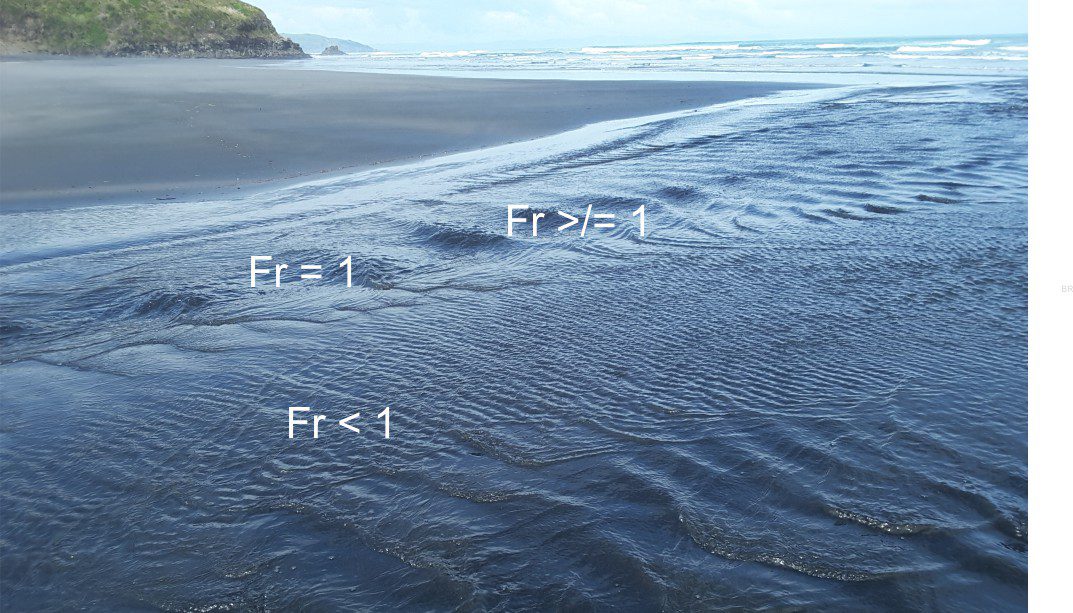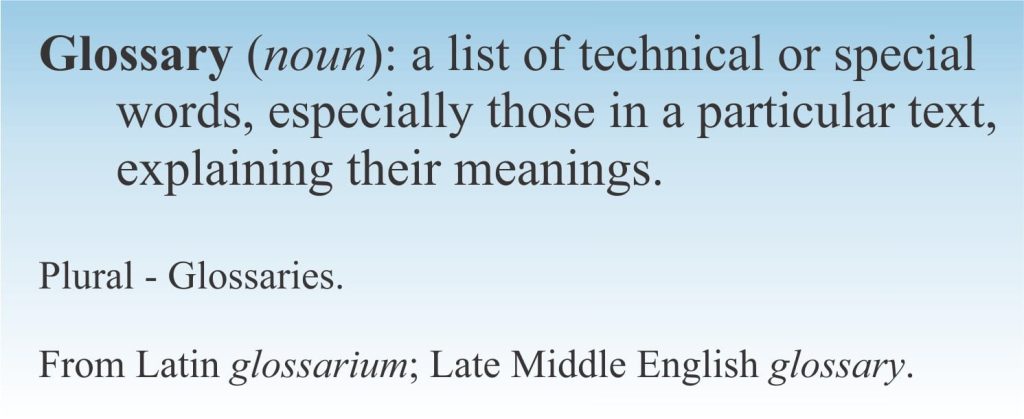 Please note – I no longer maintain Glossaries by alphabet; A, B, C… etc. All items on these pages have been moved to subject-specific glossaries such as Volcanology, Sedimentary facies and processes, and so on. The list of subject-based glossaries can be viewed in the drop-down menu on the navigation bar. These glossaries are continually updated.
Please note – I no longer maintain Glossaries by alphabet; A, B, C… etc. All items on these pages have been moved to subject-specific glossaries such as Volcanology, Sedimentary facies and processes, and so on. The list of subject-based glossaries can be viewed in the drop-down menu on the navigation bar. These glossaries are continually updated.
Darcy’s Law: Henri Darcy is credited with discovering experimentally the two important relationships:
- Groundwater flux Q is proportional to the difference in hydraulic head between two boreholes (h1 and h2) (he used manometers in his experiments). Thus, Q a h1 – h2, and
- Q is inversely proportional to the distance between the boreholes (L), or Q a 1/L
Q is also proportional to the cross-section area of flow (A). Thus, we can rewrite the two proportionalities, adding a proportionality constant k:
Q = -kA (h1 – h2)/L This is Darcy’s law.
(h1 – h2)/L is the hydraulic gradient. The proportionality constant k is the hydraulic conductivity. The negative sign indicates flow towards lower hydraulic heads.
Decay system: (isotopic) Radioactive decay is a spontaneous process. The decay from a parent isotope to its stable daughter product is called a decay system. Decay systems can incorporate a number of unstable intermediate daughter products that decay at different rates (i.e. have different half lives). For example 238U → 206Pb occurs via 14 decay products. In Zircon geochronology, three decay systems are used: ; 238U→206Pb (the half-life of 4.47 Ga is almost the same as the age of the Earth), 235U→207Pb (half-life of 0.70 Ga), and 232Th→208Pb (half-life 14.01 Ga).
Décollement: Also detachment, sole thrust. Names given to the thrust at the base of a thrust stack, that is the common surface of detachment for all thrusts. It overlies undeformed rocks (e.g. Cratonic platform, crystalline basement). An example is shown in the fold-thrust cross section below.
Decompaction: A numerical method for restoring a stratigraphic unit to its original thickness and porosity at deposition. It is an important part of geohistory determinations that tease apart the different components of basin subsidence and basin accommodation. Also backstripping.
Debris flow: A variety of sediment gravity flow containing highly variable proportions of mud, sand, and gravel, in which the two primary mechanisms for maintaining clast support are (mud) matrix strength and clast collisions. Unlike turbidites, there is no turbulence, hence normal grading is poor. Some debris flows develop significant internal shear that imparts a crude stratification and/or an alignment of clasts. Terrestrial flows include highly mobile mud flows, and lahars in volcanic terrains.
Deep water waves: Waves that do not interact with the sea floor. This applies to open ocean wind-driven waves, the speed of which depends only on the ratio of wavelength to wave period. Deep-water waves occur where water depth is greater than half the wavelength. Cf. shallow water waves.
Delamination: The decoupling, or separation of upper crust from lower crust and/or mantle lithosphere. The main driving mechanism is negative buoyancy in the mantle lithosphere such that it detaches from the crust and sinks into the asthenosphere. Delamination commonly occurs above crustal-scale thrust faults.
Delta front: A general description of delta components, or subenvironments, at and beyond the mouth of distributary channels and the coastal margin, including distributary mouth bars and prodelta.
Delta plain: The portion of a delta that is transitional between fluvial and delta front environments. It is a low-gradient area that contains distributary channels, and overbank regions that include vegetated swamps, marshes, and ponded areas. It also includes interdistributary bays.
Dense rock equivalent (DRE): A conversion from the volume of fragmental deposits (ash, lapilli, blocks) to an equivalent volume of non-fragmented lava. DRE values are used to compare the magnitude, or total volumes of eruptions.
Depocenter: The term applied to the region of thickest sediment accumulation in a basin, that also corresponds to the region of maximum subsidence. The depocenter may be axial, as is the case for passive margins, foreland basins and accretionary prisms, or more central as in intracratonic basins. It may also migrate as basin dynamics evolve, for example the craton-advancing load of a foreland fold-thrust belt. Depocenters can be determined from sediment isopach maps.
Depositional dip: Corresponds to the maximum slope of a depositional surface, normal to depositional strike.
Depositional episode: Introduced by D. Frazier (1974) working on Gulf Coast stratigraphy. They are basically cyclic repetitions of strata packages that begin with sedimentary facies deposited as a prograding succession, and end with transgression. Cf. Genetic sequence.
Depositional sink: That part of a sediment routing system at the endpoint for deposition. It can occur anywhere in a sediment routing system, including the transfer zone, where there is sufficient accommodation to enable its preservation. See source to sink.
Depositional system: A 3-dimensional assemblage of genetically related environments (in modern systems), and lithofacies in ancient systems. As an example, modern and ancient deltas contain distributary channels, delta plains, crevasse splays, beaches, bars, and prodelta slopes. All these environments are spatially and environmentally distinct and yet they are dependent, one on the other. Together they form a delta depositional system.
Deserts: Regions that receive less than 250 mm of precipitation a year and are generally in continuous moisture deficit. Whatever life forms live in these environments have adapted to the harsh conditions. Most modern hot deserts are located between the Tropics of Cancer and Capricorn that are bathed by the trade winds. The main cold deserts are at the two poles. There are also mid-latitude deserts (Sonoran in USA, Tengger in China) a,d coastal deserts such as Atacama that commonly receives <1mm rain a year.
Desert varnish: A coating of clays, iron-manganese oxides and amorphous silica that produce black to reddish hues on the surface of bedrock and sediment particles that are exposed for long periods in arid desert environments. Coatings are only a few microns thick.
Desiccation cracks: Polygonal fracture patterns that develop across the surface of drying mud surfaces. Also called mud cracks. The cracks will be filled by sediment during subsequent flooding. Desiccation polygons are also prone to erosion and break-up during subsequent inundation. They can form almost anywhere that muddy sediment is subaerially exposed.
Detachment: see décollement
Dewatering: This is the process where interstitial fluids are ‘squeezed’ from sediment during compaction, as sedimentary grains become more closely packed. The process of dewatering increases fluid pressures and promotes fluid flow in aquifer-like deposits. Fluid escape my be diffuse, or focussed through narrow pipes and sheets. It is an important stage of mechanical diagenesis, but it also contributes to chemical diagenesis by transferring dissolved mass from one part of the sedimentary column to another. Cf. liquefaction, fluidization, fluid escape structures
Dextral: Something that moves or is located to the right. In fault terminology it is synonymous with right-lateral. Cf. Sinistral.
Diagenesis: The sum of physical and chemical processes in sediment, beginning soon after deposition at or immediately below the sediment-water interface, and continuing at depth in concert with increased burial temperatures, lithostatic and hydrostatic pressures, and changing fluid composition.
Diamictite: Although the term is commonly used to describe glacial deposits, it more generally refers to extremely poorly sorted deposits in which there has been negligible reworking, containing angular clasts ranging in size from clay to boulders. In glacial depositional systems, they are they form from ablation of ice in lateral, terminal and medial moraines. Clast composition may be quite variable depending on changes in bedrock composition along the path of glacier flow.
Diapir: A buoyant, mobile body acting as a fluid that intrudes to shallower levels of the crust. Salt diapirs are common, but the process also occurs with mudstones and magmas. Positive buoyancy occurs when fluid forces acting on the body exceed the gravitational forces. Diapirism in salt produces many kinds of intrusive geometries, from dome-shaped, to laterally extensive walls, sheets, and salt-cored anticlines. During intrusion the stress on the surrounding strata is accommodated by faulting and folding. Salt diapirism results in salt withdrawal from stratiform evaporites at depth imposing a kind of supply and demand limit to the size and number of diapirs that might be generated from a particular evaporite unit. The increasing overburden load plays a critical role in initiating salt instability (buoyancy disparities) and diapir rise.
Diastem: A brief hiatus, or short break in deposition or erosion that is considered a normal part of the conditions in a particular environment. For example, the break between turbidites on deep water submarine fans, or the erosional contact beneath a storm deposit on a tidal flat.
Diatoms: A diverse group of single-celled photosynthesizing algae that secrete silica along cell walls. They are an important part of the phytoplankton food web. They occur in marine and non-marine waters. When the alga dies the silica plates gradually settle on the lake and sea floor. Diatomaceous earth will form if the silica plates are sufficiently concentrated over long periods without disturbance by currents.
Diatremes: Funnel-shaped pipes (funnel opening upward) containing a chaotic mix of brecciated basement rock formed by focused explosive eruptions, commonly phreatomagmatic; many are associated with maar eruption centres. The eruptions bring deep crustal rock to much shallower levels, including those containing very high pressure minerals like diamonds. Diatremes are exposed by deep erosion of the surface cover.
Dike/dyke (geomophology): (Dike = North American; Dyke = English). Another term for either natural or engineered levee, berm or embankment along the banks of rivers or sea shores to help prevent flooding.
Dike/dyke (igneous): (Dike = North American; Dyke = English) Sheet-like magma feeders to volcanic eruption sites, that have been forced through and are oriented at a high angle to stratification or layering. Columnar jointing is common and normal to the dike walls. Dyke sheets commonly branch. Cf. igneous Sill.
Dike/dyke (sedimentary): (Dike = North American; Dyke = English) Sheet-like feeders of sediment – commonly a mix of mud, sand, brecciated host rock, that have been forced through sedimentary strata at a high angle to layering. Driving mechanisms are commonly transient elevated fluid pressures generated by compaction or seismicity.
Dilation (kinematics): Non-rigid body deformation causing a change in size (e.g. contraction). One mechanism to accomplished this is pressure solution like: common examples are stylolites in limestones, and cleavage in highly deformed rock.
Dip: Dip is the angle of inclination measured from a horizontal line at right angles to strike. It is the maximum inclination of a plane; at any other angle that lies in the plane, the dip is apparent.
Dip slip: The component of movement, or slip along a fault plane that parallels dip. It may be normal or reverse dip slip.
Dip slope: The flank of a ridge underlain by a steeply dipping resistant layer of rock, typically sedimentary. Dips are usually >30-40°. Hogbacks and Flatirons are usually identified by their dip slopes.
Directed blast: Explosive blasts that are directed laterally transform rapidly to pyroclastic flows. They are commonly generated by flank landslides, larger sector collapse, or lava dome collapse – the last mechanism was responsible for the main PDC during the 1980 eruption of Mt. St. Helens.
Disconformity: An unconformity where the overlying and underlying strata have the same orientation.
Disequilibrium compaction: Under normal conditions of compaction, fluid that is driven from pore spaces escapes without a significant increase in pore pressure – i.e. hydrostatic conditions prevail. However, rapid deposition of low permeability deposits can impede fluid flow and under these conditions pore pressures increase; this process is called disequilibrium compaction. In many basins, this occurs at about 3km burial depths. Disequilibrium compaction is enhanced by cementation and tectonic compression.
Dish structures: During early compaction and dewatering, fluid that escapes via vertical pillars and sheets will disrupt primary laminae, and in many cases remove fine matrix. The resulting structures are dish-shaped, concave upwards sand laminae. They are common in laminated sandstones that have vertical permeability gradients.
Dispersion: In geofluids this is the process where dissolved and insoluble compounds move from their source or point of origin; observed in groundwater flow, diagenesis, and metamorphism. In these contexts there are two primary mechanisms – mechanical dispersion, and molecular diffusion.
Dispersive pressure: An important mechanism of flow support in grain flows, some debris flows, concentrated pyroclastic density currents (e.g., ignimbrites) and block and ash flows, where grain-to-grain collisions transfer momentum that keeps particles dispersed. c.f. other mechanisms like turbulence, matrix strength, and fluidization.
Distortion (kinematics): Non-rigid body deformation involving a change of shape; commonly by ductile flow. For example, boudinage of thinly bedded sandstone-shale will involve brittle failure and translation, and possibly rotation of sandstone boudins, and ductile flow of the mechanically less competent shale.
Distributary channel: Channel systems on a delta plain that represent the transition from fluvial to the delta front. Channels may be straight to sinuous, single or multiple. They commonly are contained by levees. Sediment within the channels tends to be sandy, and bedforms are typically those of other sandy fluvial channels. In marine delta systems, a tidal signal will extend some way upstream, depending on channel gradient and flow competence.
Distributary mouth bar: Sand-dominated subaqueous bars and platforms that form at the coastal outlets of distributary channels where there is an abrupt decrease in flow velocity. The coarsest sediment will be deposited close to channel mouths (outlets), with finer-grained material moved farther offshore.
Distributed conduit: Fault zones that contain more than one major fracture plane. Distributed conduits potentially have greater permeability than single fault planes, providing additional pathways for fluid flow.
Downlap: Downlapping clinoforms terminate on top of the basin floor (marine and lacustrine). Downlap units must have a dip greater than the surface at which they terminate. Clinoform profile is typically progradational. See also onlap, toplap, offlap.
Drag fold: Folds produced during faulting as a result of shear strain distributed beyond the fault plane into the adjacent rock. They are useful (kinematic) indicators of fault displacement.
Drape fold: Strata deformed as folds over pre-existing structures or topography. Drape folding can occur in soft sediment or as ductile deformation in indurated rock.
Drusy cement: Cements consisting of calcite rhomb mosaics that line and fill pores, intraskeletal chambers, and more cavernous porosity. The size of calcite rhombs commonly increases towards the center of void spaces. Intercrystalline boundaries tend to be planar. They are common in meteoric and burial environments where they may overlie earlier fibrous or bladed cements.
Ductile deformation (flow): Deformation (strain) beyond a material’s elastic limit that is permanent (not reversable), but does not result in fracturing (brittle failure) – i.e. the material is behaving as a plastic. Materials that deform ductily appear to flow or bend. Ductile deformation of rock is enhanced under conditions of high confining pressures, high temperatures, and low strain rates.
Duplex: An imbricate stack of horses bound above and below by through-going thrusts; these are the roof and floor thrusts. Duplexes represent progressive, incremental formation of ramps and bending folds (anticline-syncline pairs). Duplexes can take several geometric forms
Dynamic topography: Long wavelength topography that is produced by mantle convection beneath the lithosphere. Wavelengths are measured in 100s of kilometres. The topography can be positive (uplift) or manifested as subsidence. Theoretically this effect can produce shallow basins in the absence of tectonism. Conversely, the subsidence of sedimentary basins that originate primarily by tectonics, such as foreland basins, may be enhanced by down-welling mantle convection cells.

